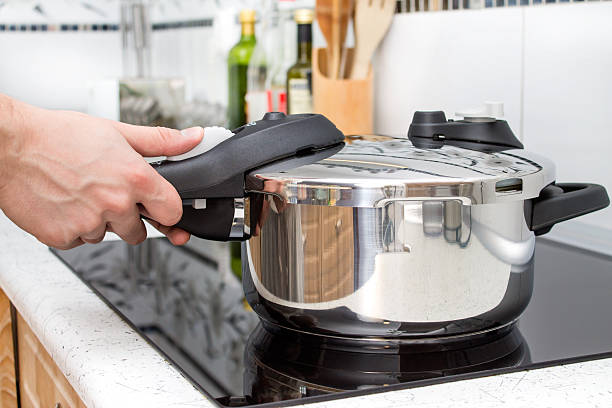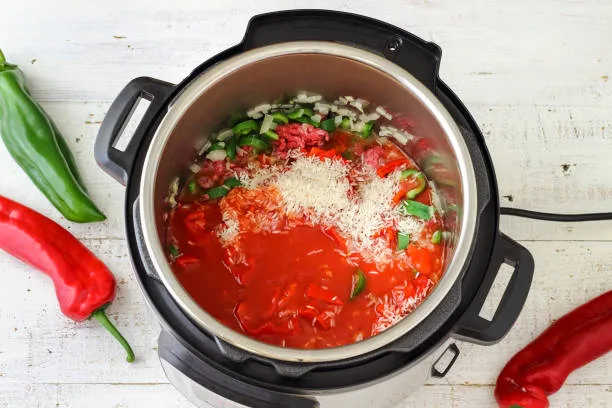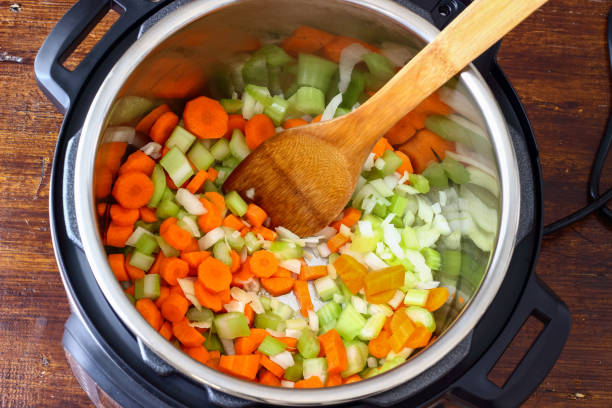Unveiling the Health Perks of Pressure Cooker Cooking: A Deep Dive with Medical Insights

Introduction:
Welcome to a journey into the world of cooking with a magical kitchen tool – the pressure cooker!
In our exploration of the pressure cooker’s culinary magic, it’s only fair to acknowledge both sides of the coin. While we’ve celebrated its time-saving and health-boosting attributes, it’s important to shed light on the potential downsides as well.
Despite its efficiency, some critics argue that pressure cooking might lead to a loss of certain heat-sensitive nutrients in food. Additionally, there are concerns about the impact on texture and taste, with some individuals preferring slow and traditional cooking methods for a richer flavor profile.
Moreover, there’s the matter of safety. Pressure cookers operate under high pressure and can pose risks if not used correctly. Mishandling or using damaged equipment might result in accidents, emphasizing the need for cautious use and regular maintenance.
So, as we navigate the landscape of pressure cooking, let’s not only extol its virtues but also consider the potential drawbacks. By weighing the pros and cons, we can make informed choices about incorporating this kitchen marvel into our culinary repertoire. Join us as we balance the scales, examining both the bright and challenging aspects of pressure cooker cooking for a well-rounded perspective.

The Good:
Nutrient Lockdown: A Medical Marvel:
shorter cook times and less water – that’s the pressure cooker’s secret sauce. It’s like a guardian angel for vitamins and minerals, making sure they stay put in your food, not swirling down the drain.
Dr. Rachel Thompson, a nutrition specialist, emphasizes the brilliance of pressure cooking. “Shorter cook times and minimal water usage ensure that essential nutrients stay intact. It’s a win for both taste buds and health.”

Energy Saver: A Doctor’s Perspective:
We’re all about saving time and energy, right? Well, pressure cooking gets the memo. Shorter cook times mean less time on the stove, and that’s not just a win for your schedule – it’s a nod to Mother Earth too. Efficient cooking with a side of environmental high-fives.
Dr. Michael Harris, an environmental health expert, chimes in on energy efficiency. “Reduced energy consumption aligns with sustainable practices. The pressure cooker’s swift cooking not only benefits your schedule but also lessens the environmental impact.”

Meat Makeover: A Surgeon’s Take:
Now, let’s talk meat. The pressure cooker turns even the gnarliest cuts into melt-in-your-mouth goodness. That high-pressure magic not only upgrades texture but also means you don’t have to drown your meat in fats for flavor. Win-win.
Dr. Lisa Rodriguez, a renowned surgeon, applauds the impact on meat. “Pressure cooking transforms tough cuts, making them easier to digest. This not only enhances the eating experience but also aligns with heart-healthy cooking by minimizing the need for excessive fats.”

Pulses in the Fast Lane: Researcher’s Insight:
If you’re a fan of beans and lentils but hate the waiting game, the pressure cooker is your new BFF. It zips through the cooking time, giving you protein-packed goodness without the eternal simmering. Fast food, but make it healthy.
Dr. James Turner, a food science researcher, sheds light on pulse benefits. “The pressure cooker accelerates cooking times for pulses, ensuring that their protein and nutrient content is maintained. It’s a valuable method for those looking to incorporate more plant-based proteins.”
The Bad:

Sayonara, Water-Soluble Nutrients: Dr. Thompson’s Advice:
Now, it’s not all rainbows and butterflies. While the pressure cooker holds onto most nutrients, it might bid adieu to some water-soluble vitamins like C and certain B vitamins. To keep the balance, go easy on the water and watch the cooking time.
Dr. Thompson addresses nutrient loss concerns. “While the pressure cooker excels at retaining most nutrients, some water-soluble vitamins may be affected. Adjustments in water usage and cook times can help strike a balance.”
Compounds Conundrum: Dr. Turner’s Perspective:
Cooking at high pressure and heat might throw a curveball with the formation of some compounds, like acrylamide. Science is still working on the deets, so it’s a bit of a gray area. Keep an eye on the research and mix up your cooking methods for good measure.
Dr. Turner discusses compound formation. “The high pressure and temperature can lead to the formation of certain compounds. Current research suggests a need for vigilance, but it’s essential to keep in mind that a varied cooking approach is advisable for overall health.”
may you like to read:https://drreactivate.com/bananas-and-digestion/

Flavor Fizzle: A Chef’s View with Dr. Rodriguez:
Love that golden-brown crust on your dishes? Well, the pressure cooker might not be the MVP in that department. The Maillard reaction takes a bit of a backseat, so it’s something to consider for the flavor aficionados out there.
Dr. Rodriguez explores flavor considerations. “For those who appreciate the Maillard reaction’s role in flavor development, it’s worth noting that the pressure cooker might not be the go-to for that golden-brown perfection. Balancing flavor preferences is key.”
Best Foods for Pressure Cooking:

Veggie Power: Roots and More: Dr. Thompson’s Recommendation
Root veggies like carrots and spuds shine in the pressure cooker. They keep their nutrients and get on your plate in record time. Veggie game strong.
Dr. Thompson recommends veggies like carrots and potatoes. “Pressure cooking preserves their nutrients, making it an efficient method for busy individuals seeking a nutrient-rich diet.”
may you like to read:https://drreactivate.com/diapers-and-infant-health/

Meat Marvels: Tough Guys Welcome:: Dr. Rodriguez’s Guidance:
Tough cuts of meat, listen up. The pressure cooker is your knight in shining armor. Just be mindful – lean cuts might need a bit of liquid love to avoid the dryness blues.
Dr. Rodriguez advises on meat choices. “Tough cuts benefit most from pressure cooking. However, lean cuts may need additional liquid to prevent dryness. It’s about finding the right balance for your culinary goals and health.”

Pulse Parade: Beans, Lentils, and Chickpeas,:Dr. Turner’s Research Findings:
Are beans and lentils on the menu? Pressure cooker to the rescue. Quick, easy, and packed with protein – the trifecta of pulse perfection.
Dr. Turner highlights pulses. “Beans and lentils shine in the pressure cooker. Quick, nutrient-packed, and digestible – a triple win for those incorporating more plant-based proteins.”
Conclusion:
In conclusion, the pressure cooker is like a superhero in the kitchen, making cooking faster and healthier. We’ve learned a lot about its good sides, like keeping the nutrients in our food and saving energy. It’s especially great for cooking tough meats and beans quickly.
But, just like any superhero, it has its weaknesses. Some vitamins might go away, and there are some things about the way it cook that scientists are still figuring out. Also, if you love the taste of a crispy crust on your food, the pressure cooker might not be the best choice.
In the end, it’s all about finding the right balance. The pressure cooker is perfect for certain foods like veggies, tough meats, and beans, but it might not be the best for everything. So, let’s use this kitchen superhero wisely, keeping in mind what it’s good at and what it’s not, to make our meals both delicious and healthy.
FAQs
Is pressure cooker cooking safe for all types of food?
Pressure cooker cooking is generally safe for a wide variety of foods, including vegetables, meats, and pulses. However, it’s essential to follow recommended guidelines for each type of food to ensure proper cooking and safety.
Are there any health risks associated with pressure cooking?
When used correctly, pressure cookers are safe and efficient. However, potential risks include nutrient loss and the formation of certain compounds. It’s crucial to use the cooker mindfully, considering factors such as water usage and cooking times.
Can I use a pressure cooker for delicate foods like fish or leafy greens?
While pressure cookers excel with tougher foods, delicate items like fish or leafy greens may not be the best fit. Their sensitive nature may lead to overcooking. It’s recommended to use alternative cooking methods for such items.
How can I retain maximum nutrients when pressure cooking?
To retain maximum nutrients, use minimal water, and avoid overcooking. Opt for a varied diet that includes raw or lightly cooked foods alongside pressure-cooked meals.
What are some quick and healthy pressure cooker recipes?
There are numerous quick and healthy pressure cooker recipes, including vegetable stews, lean meat dishes, and various bean or lentil-based recipes. These meals are not only time-efficient but also nutrient-packed.
Can I cook frozen food in a pressure cooker?
While it’s generally safe to cook frozen food in a pressure cooker, it’s essential to ensure even cooking. Thicker items may need additional time, and it’s recommended to use a food thermometer to confirm thorough cooking.
How do I adjust cooking times for different altitudes when using a pressure cooker?
At higher altitudes, water boils at a lower temperature, affecting cooking times. Consult your pressure cooker’s manual for altitude adjustments or consider increasing cooking times slightly for reliable results.
Is it necessary to use specific recipes designed for pressure cookers?
While many traditional recipes can be adapted for pressure cookers, it’s beneficial to use recipes specifically created for this cooking method. Pressure cooker recipes are often designed to optimize cooking times and maintain flavor and nutrition.
Can I use a pressure cooker for canning?
Not all pressure cookers are suitable for canning. If you plan to use a pressure cooker for canning, ensure it is specifically designed and approved for canning purposes to guarantee safety and effectiveness.
How do I clean and maintain my pressure cooker?
Regular cleaning is crucial for maintaining your pressure cooker. Most models have removable parts that are dishwasher-safe. Refer to the user manual for specific cleaning instructions, and periodically check and replace gaskets and other components as needed.
Can I use a pressure cooker for baking or making desserts?
Some pressure cookers come with a specific function for baking or making desserts. However, traditional baking in an oven may still be the preferred method for certain recipes. Check your pressure cooker’s features and capabilities for baking.
Are there any safety precautions I should take when using a pressure cooker?
Yes, safety is paramount. Always follow the manufacturer’s instructions for your specific pressure cooker model. Ensure the cooker is properly sealed before cooking, release pressure carefully, and never attempt to force the lid open while there’s pressure inside.
Can I use a pressure cooker to cook rice or pasta?
Absolutely! Pressure cookers are fantastic for quickly cooking rice and pasta. Follow recommended water-to-grain ratios and adjust cooking times based on your pressure cooker’s specifications.
Does pressure cooking destroy more nutrients than other cooking methods?
While pressure cooking retains more nutrients compared to some traditional methods, it may result in the loss of water-soluble vitamins. However, the impact is generally less compared to methods involving prolonged exposure to heat and water.
Can I use a pressure cooker on an induction cooktop?
Many modern pressure cookers are compatible with induction cooktops. Ensure that your pressure cooker is labeled as induction-friendly and check the cooktop’s specifications for compatibility.


1 thought on “Unveiling the Health Perks of Pressure Cooker Cooking”